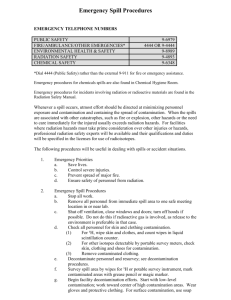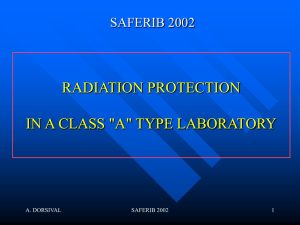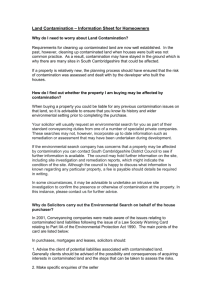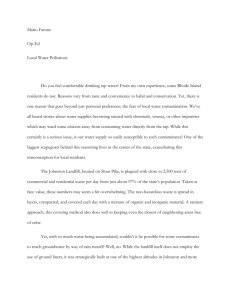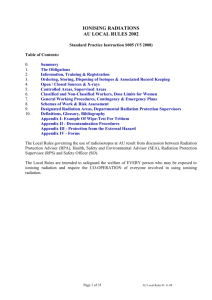NSQI LNL Ionising Radiation Scheme of Work
advertisement
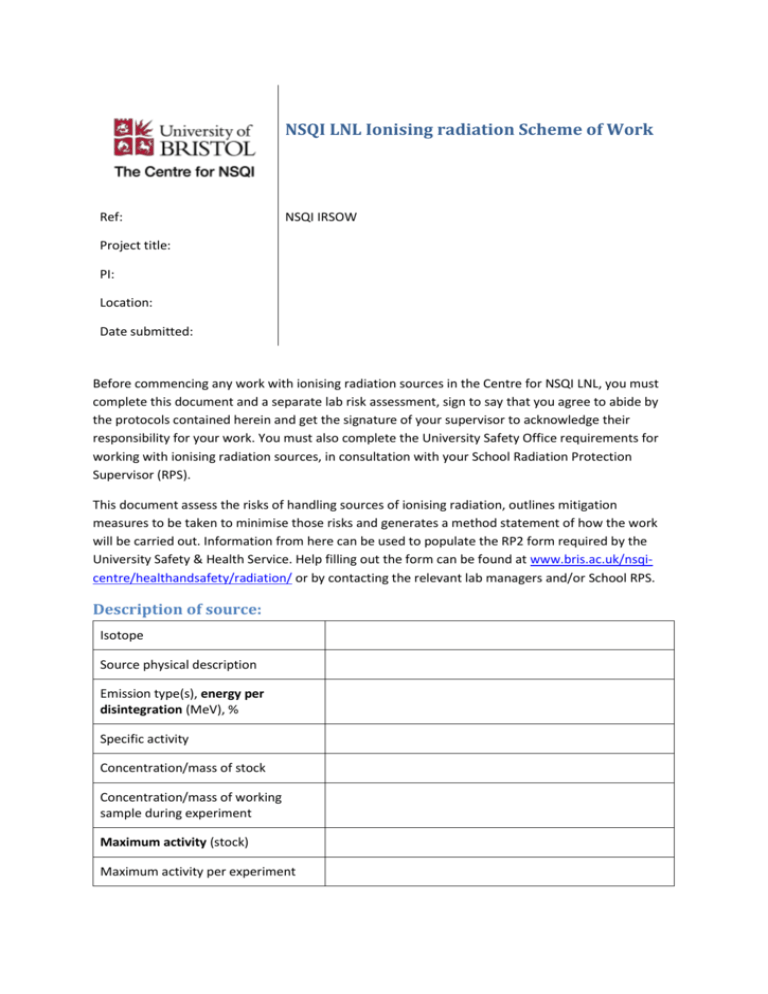
NSQI LNL Ionising radiation Scheme of Work Ref: NSQI IRSOW Project title: PI: Location: Date submitted: Before commencing any work with ionising radiation sources in the Centre for NSQI LNL, you must complete this document and a separate lab risk assessment, sign to say that you agree to abide by the protocols contained herein and get the signature of your supervisor to acknowledge their responsibility for your work. You must also complete the University Safety Office requirements for working with ionising radiation sources, in consultation with your School Radiation Protection Supervisor (RPS). This document assess the risks of handling sources of ionising radiation, outlines mitigation measures to be taken to minimise those risks and generates a method statement of how the work will be carried out. Information from here can be used to populate the RP2 form required by the University Safety & Health Service. Help filling out the form can be found at www.bris.ac.uk/nsqicentre/healthandsafety/radiation/ or by contacting the relevant lab managers and/or School RPS. Description of source: Isotope Source physical description Emission type(s), energy per disintegration (MeV), % Specific activity Concentration/mass of stock Concentration/mass of working sample during experiment Maximum activity (stock) Maximum activity per experiment Protocol Description of project/aims: Storage of source: Overnight secure storage/ stock storage type & location: Lab storage: Transport of source: Route: Transport containment: Daily lab procedure: Source preparation: Experimental procedure: Hazards Dose Calculations On the UoB site Grays are equivalent to Sieverts, therefore: Beta dose = 0.81 x Maximum Activity mSv. h-1 at 10 cm distance = mSv. h-1 at 10 cm distance Gamma dose = 0.15 x Maximum Activity x Total Energy per Disintegration µSv. h-1 at 1 m distance = µSv. h-1 at 1 m distance Exposure limits: Annual = 50 mSv Hourly Dose rate = 25 µSv. h-1 Bremsstrahlung likelihood: Possible routes of contamination: Contamination route 1. Estimated likelihood 2. Possible radiation & contamination exposure routes: Exposure routes (i.e. external, inhalation, ingestion) 1. Estimated likelihood 2. Other hazards: (i.e COSHH, CHIP/GHS categories, reactivity, localised heating etc) Hazard identified 1. 2. Control measures Shielding (during storage, transport, handling, experiment etc): Material to be used: Thickness: Estimated risk to user PPE requirement & protection level/duration: Area designation & Access: Room designation: Area designation: Monitoring procedure: Equipment to be used & location of equipment: Procedure followed: Personal dosimetry requirement: Decontamination procedure: Additional PPE required: Materials used: Procedure: Disposal: See waste section Precautions for ‘Other hazards’ 1. 2. Waste disposal: All disposal of Radioactive material MUST be recorded on the Ionising Radiation Safety database (https://safe-srv.sft.bris.ac.uk/usermenu.php) The database is also used to request a new bin for disposing of radioactive material The system will also prompt you to dispose of the waste bin every two months, unless disposed of otherwise. Security measures: Card access by request only to basement and wet lab corridors as standard. Card access to wet lab, key access to basement labs as standard – basement lab door must be kept locked while source is present. Source material signed into and out of building Secure overnight storage Training required: All training must be recorded by NSQI LNL management, to be shared with NSQI & School RPSs 1. Safety & Health Service ionising radiation training 2. NSQI LNL lab induction 3. Local experimental training: Emergency procedures First aiders Pete Dunton Alex Martin Ext. 40013 Ext. 40001 Treatment of serious injury takes precedence over dealing with contamination. All contaminated materials must be bagged as radioactive waste. Severe injury involving radioactive contamination Call for medical assistance, either summon assistance from colleagues, local first aider or dial the security emergency number 112233 who will then dial 999 When dialling 112233, state name, location of injured and nature of injury and radionuclide(s) involved. Inform Radiation Protection Adviser (RPA) on ext. 88323 / 88780. Outside normal working hours contact Security for calling RPA. If possible without causing further injury attempt to remove contaminated clothing such as lab coat, gloves. When ambulance arrives inform them that the casualty might be contaminated. Minor injury involving radioactive contamination To prevent spread of further contamination, the contaminated person should be moved away from the immediate contamination but not from the laboratory. Warn others in the laboratory. Call for a First Aider to render first aid. Monitor the contaminated person and carefully attempt to remove contaminated clothing. Contamination should be washed from the body using a gentle detergent. Do not use abrasives or hard brushes. If there is facial contamination it should be rinsed away from the eyes, nose and mouth. Do not break the skin. Notify the RPS or the RPA via the Health and Safety Office, on ext.88323 / 88780 if the RPS is unavailable. Accidents involving “unsealed” radioactive materials – no personal injury Local rules should contain instructions for emergency actions in the event of a spill. These should take precedence. Retreat from the immediate area. Summon assistance, taking care not to spread contamination Warn others in laboratory Monitor and if necessary remove contaminated clothing Inform the RPS or RPA in the Health and Safety Office if the RPS in unavailable Decontaminate personnel as for minor injuries Seal off the area to prevent unauthorised access. Turn off laboratory services if necessary. Assess the personal protective equipment requirements. (Dry material may require some form of respiratory protection). Wearing overshoes, clean lab coats and gloves begin decontamination process, taking care not to spread contamination. Clean from the perimeter of the spill inwards to reduce the spread. All contaminated material must be bagged for assessment before disposal. If contamination is stubborn a proprietary abrasive cleaner should be used, If in doubt contact the RPA for advice (ext. 88323). Accident involving radiation exposure If possible remove the source – either turn off beam or evacuate the area Call for medical assistance, either summon assistance from colleagues or dial 999 When dialling 112233 state name, location of injured, nature of injury and radiation incident that has occurred Inform the RPA on ext.88323 Outside normal working hours contact Security for calling RPA. Fire involving radioactive materials Raise the alarm Warn others in laboratory and adjacent rooms If contaminated and time permits remove personal clothing If time permits ensure all radiation sources are suitably stored/shielded Evacuate area When in safe area or outside building dial 112233 and confirm it is a real fire to Security who will then call the fire brigade. Please report status of source to security. If serious injuries have occurred then ask Security for an ambulance to be called. Fire evacuation Leave the lab immediately The lab door should be locked behind you Once outside report status of the source to the fire warden in charge of the evacuation. In the event of loss/theft: Report any missing radioactive material to the RPA (Tony Butterworth – ext. 88323) in the Safety & Health Service. Any missing material must be investigated immediately. Name of assessor: Authorised users: 1. 2. Last review Date: Next review date:
